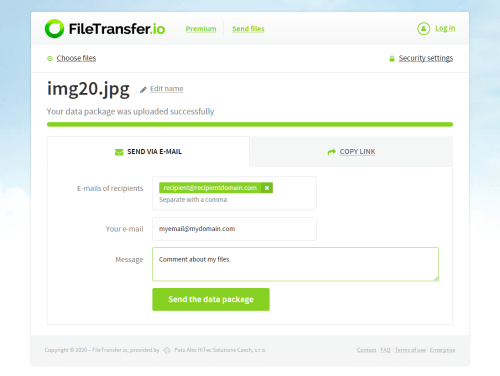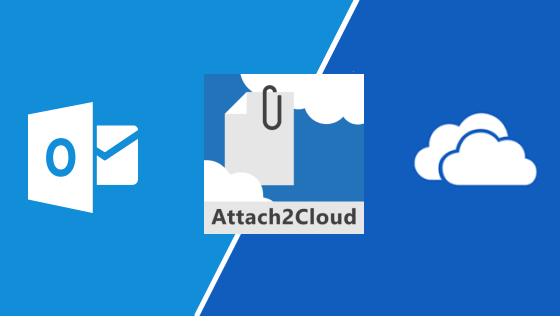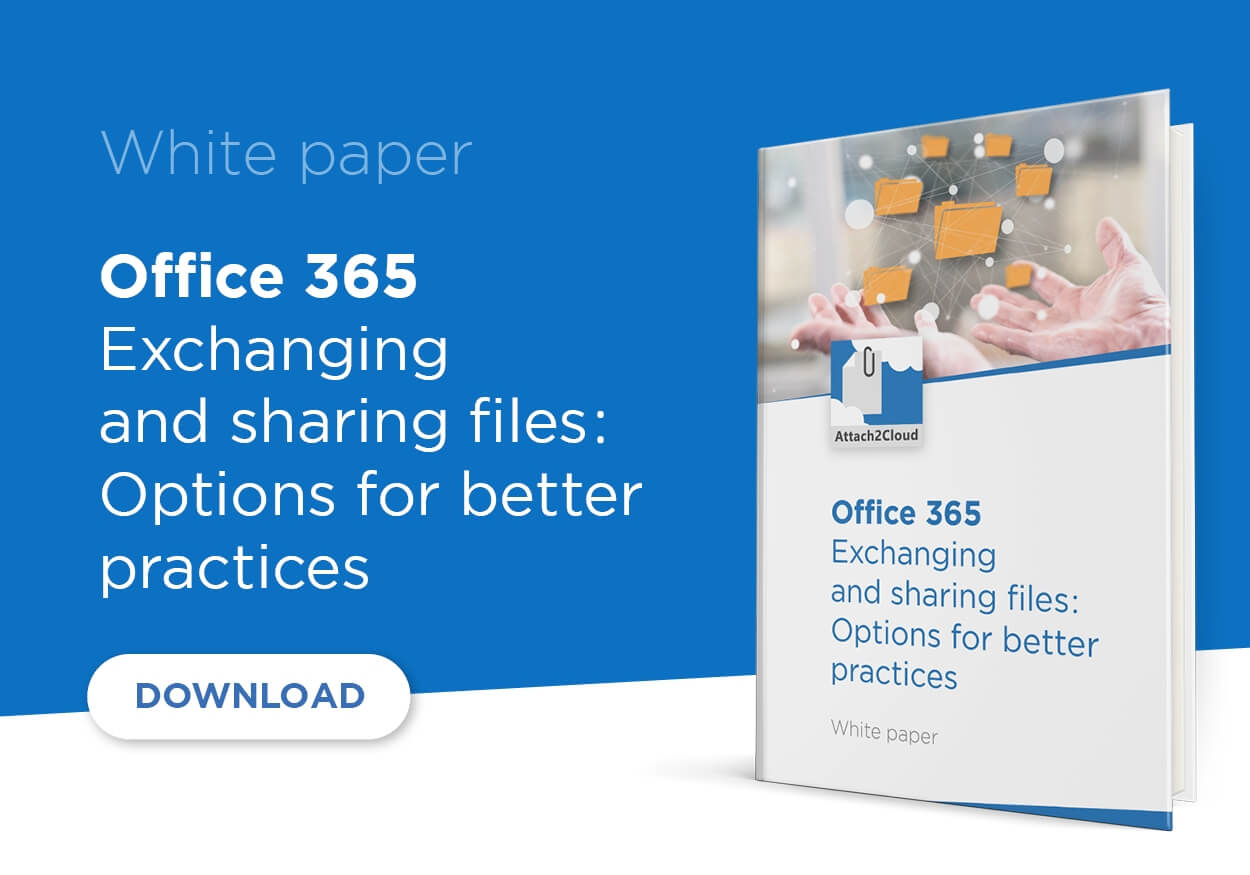An alternative to FileTransfer.io (based on Outlook and OneDrive) for large file transfers
Limitations in terms of maximum Outlook email size, relative complexity of the OneDrive document sharing process with third parties outside the organization, confusing OneDrive user interface with too many steps, low level of integration between Outlook and OneDrive, lack of user training… these are probably the main reasons that may explain the seemingly paradoxical craze for free online file exchange services such as FileTransfer.io or WeTransfer at some corporate Office 365 customers, especially those who need to exchange very large files. But CIOs have serious security concerns and are looking for alternatives to FileTransfer.io, WeTransfer and other similar services.
FileTransfer.io, an attractive service for users needing to exchange very large files…
 Extremely easy to use, the free version of FileTransfer.io, which has a maximum file size limit of 6 GB (compared to 2 GB for the free version of WeTransfer), appeals to many users.
Extremely easy to use, the free version of FileTransfer.io, which has a maximum file size limit of 6 GB (compared to 2 GB for the free version of WeTransfer), appeals to many users.
Links to files uploaded on FileTransfer.io can be sent by email in a few clicks, and files stored on the platform can be downloaded up to 50 times, which is quite generous for a free service. The documents remain accessible 21 days via the generated download links (compared to 7 days with WeTransfer). With its minimalist, intuitive, simple and practical UI, FileTransfer.io has what it takes to attract your collaborators wishing to exchange large attachments exceeding the maximum allowed email size.
…but CIOs have serious concerns and are looking for alternatives to FileTransfer.io
 Although its user interface appears very attractive, using FileTranfer.io cannot be considered as totally risk-free from the CIO’s point of view. Indeed, the information available on the platform’s website is very limited… and not very reassuring; The conditions of use being governed by Czech law, it is advisable to remain vigilant on the security and confidentiality aspects, especially since FileTransfer.io indicates very clearly that file transfers performed via free accounts are not secure. This precision, if it has the merit of transparency, is enough to alarm the CIOs.
Although its user interface appears very attractive, using FileTranfer.io cannot be considered as totally risk-free from the CIO’s point of view. Indeed, the information available on the platform’s website is very limited… and not very reassuring; The conditions of use being governed by Czech law, it is advisable to remain vigilant on the security and confidentiality aspects, especially since FileTransfer.io indicates very clearly that file transfers performed via free accounts are not secure. This precision, if it has the merit of transparency, is enough to alarm the CIOs.
Indeed, CIOs are always very worried, not only to see files containing potentially sensitive corporate data exchanged via platforms declaring themselves zero guarantee in terms of security and confidentiality, but also about corporate users connecting to platforms potentially vulnerable to attacks of all types (malware, ransomware, phishing) that could cause damages to their users and to the recipients of their files as well, attacks for which files are ideal vectors.
There is also another concern about the possible reuse, by the platforms or by third parties, of the email addresses of the users and those of the recipients of their files. Free services have to cover their expenses as any other businesses and most often, users of these services are in fact the product generating the revenues in one way or another.
Declared lack of security and confidentiality guarantees, conditions of use governed by Czech law, environment prone to malware, ransomware, phishing and to possible reuse of user email addresses are risks that no CIO is ready to assume.
Is there an alternative to FileTransfer.io that could compete on the topic of the exchange of large files? Or, still better, a way to convince Office 365 corporate users to adopt OneDrive to share their large files?
Good news: the answer is yes to both questions!
A secure alternative to FileTransfer.io based on Outlook and OneDrive
 For Office 365 customers, it would be of course preferable, in terms of security and confidentiality, that their users remain in the corporate Office 365 secure environment to share their large files. On this topic, it seems somewhat surprising, if not paradoxical, that a significant number of corporate Office 365 users make use of public and unsecure file exchange services in the Cloud, such as FileTransfer.io or WeTransfer to share their large files. Indeed, from a technical point of view, OneDrive (that is included in Office 365 subscriptions) could perfectly provide this service to them.
For Office 365 customers, it would be of course preferable, in terms of security and confidentiality, that their users remain in the corporate Office 365 secure environment to share their large files. On this topic, it seems somewhat surprising, if not paradoxical, that a significant number of corporate Office 365 users make use of public and unsecure file exchange services in the Cloud, such as FileTransfer.io or WeTransfer to share their large files. Indeed, from a technical point of view, OneDrive (that is included in Office 365 subscriptions) could perfectly provide this service to them.
Why this paradox?
The reasons are probably to be found in the relative complexity of OneDrive; its numerous menus scattered here and there, its access permissions to shared files (read-only, modifications allowed) linked to the different types of recipients (recipients of the OneDrive shortcuts to the files, message recipients, recipients who are members of the organization), the necessary authorization requests (for external recipients of secure OneDrive shortcuts) allowing their automated declaration in Active Directory (a prerequisite for accessing the shared files) and requiring them to have a Microsoft account or an @outlook.com address…
This complexity not only discourage OneDrive adoption and usage, but also results, too often, in external recipients failing to download OneDrive files shared with them because the authentication email automatically sent to them by OneDrive is intercepted by their anti-spam, or because they do not have a Microsoft account (and maybe do not want to create one), and also, in many cases, because the procedure is not clearly explained, neither to the Office 365 users sharing their files nor to the external recipients receiving emails containing OneDrive shortcuts to these shared files with no instructions.
These reasons also explain why, at many Office 365 customers, the adoption rate of OneDrive remains very low, as users continue to exchange their files as Outlook attachments as long as the size of their files remains below the maximum size allowed for their Outlook messages.
Compared to OneDrive, FileTransfer.io is incredibly easy to use
Once you have uploaded your files on the platform, sending a message containing a download link to these files by email is almost instantaneous. It is not surprising to see some OneDrive users, frustrated by the failure of previous attempts to exchange files with external recipients and/or discouraged by the complexity of the process, turning to Filetransfer.io to exchange files that are too large to be sent as Outlook attachments. Once OneDrive users have tried it, they certainly consider that there is no simpler alternative to FileTransfer.io.
Unfortunately these users do not always realize the high level of risk involved in using such platforms.
An innovative and pragmatic alternative to FileTransfer.io, combining simplicity and security?
For Office 365 users, there is an alternative to FileTransfer.io for exchanging large files (as well as others): Attach2Cloud
Attach2Cloud is an alternative to FileTransfer.io, We Transfer and others that allows Office 365 customers to automatically redirect large file exchanges to OneDrive without requiring any training of their users.
Indeed, this Outlook add-in allows Outlook users to attach files up to 250 GB per file (1) to their emails and to load Outlook attachments onto OneDrive automatically or semi-automatically, optionally based on rules according to their size, type etc.
With Attach2Cloud, all Outlook users have to do to upload and share large attached files in OneDrive is to simply attach them to an email. There is no Outlook maximum message size limit anymore! Their large attached files are then automatically uploaded to OneDrive, shared with the recipients of the email and replaced by OneDrive shortcuts when the email is sent.
Users don’t have to do anything special. They attach their large files to their Outlook emails just like any other files. They can even attach folders (Attach2cloud will automatically compressed them into Zip files before uploading them to OneDrive) simply by dragging them into their Outlook emails. All operations related to uploading and sharing attachments on OneDrive take place in the background when the email is sent. Users can continue to work in Outlook while the attachments are being uploaded on OneDrive.
(1) These huge files are, of course, not really attached to the Outlook emails and are automatically uploaded to OneDrive when the emails are sent. But for Outlook users, everything happens as if these files were really attached to their emails. The limit for the maximum unit size of an attached file is 250 GB, which is in fact the maximum size of a OneDrive file. The number of attachments is not limited and the Outlook emails themselves no longer have any size limitation!
Curious to know more?
Here is a video of a demo of Attach2Cloud in 1 minute and 46 seconds.
You can also have a look at this page on the specific topic of the exchange of very large files.
As you can see in the demo above, Attach2Cloud is the most natural, quick and easy way for your Office 365 users to exchange files, large or small. In addition, by relying on OneDrive for file storage and sharing, it gives your users, as well as their external correspondents when necessary, access to all the advanced collaboration features offered by Office 365, such as online co-editing of Word Excel and PowerPoint documents, advanced document sharing, version management, protection against accidental deletion… which are not available in free file exchange services such as FileTransfer.io or WeTransfer.
Fully transparent, the Attach2Cloud add-in is an ideal alternative to FileTransfer.io that appeals to both users and CIOs.
On the one hand, Office 365 users can now attach their large files (or not) in the blink an eye, directly in their Outlook emails, without even thinking about it, as they are used to do for other files, and without the need to use a third-party online service.
On the other hand, CIOs are most pleased to find, with Attach2Cloud, a very powerful ally in their fight against Shadow IT, enabling them to redirect large file exchanges to their secure Office 365 environment, and this, automatically and naturally, without having to edict rules or to fight against users risky practices in this matter.
On the top of this, seeing their users adopting OneDrive effortlessly and thus, finally benefiting from the advanced collaboration features of Office 365 (all of which are based on OneDrive), is definitely another important source of satisfaction for the CIOs, and not the least.
Test Attach2Cloud for yourself:
Download the fully functional Attach2Cloud evaluation version. You can install it on as many computers as needed.
Any questions?
Make sure to contact us, we’ll be most pleased to answer!
Search:
Points of view category
Previous post:
← Outlook OneDrive integration using Power Automate (Flow), interesting perspectives?
Points of view category
Next post:
Attach2Cloud: your best bet to boost OneDrive adoption?
